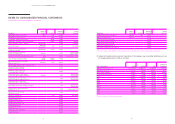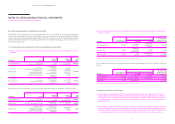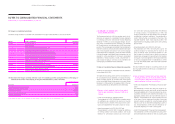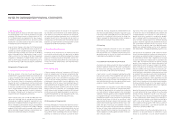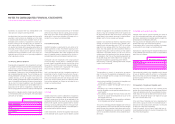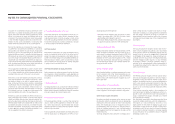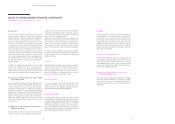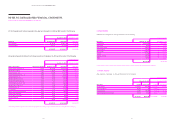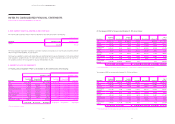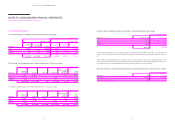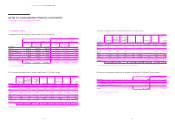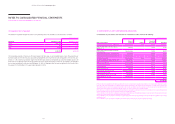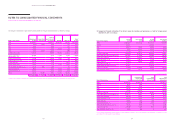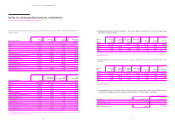Hyundai 2015 Annual Report Download - page 57
Download and view the complete annual report
Please find page 57 of the 2015 Hyundai annual report below. You can navigate through the pages in the report by either clicking on the pages listed below, or by using the keyword search tool below to find specific information within the annual report.
HYUNDAI MOTOR COMPANY Annual Report 2015
112 113
(25) Fair value
Fair value is the price that would be received to sell an asset
or paid to transfer a liability in an orderly transaction between
market participants at the measurement date, regardless of
whether that price is directly observable or estimated us-
ing another valuation technique. In estimating the fair value
of an asset or a liability, the Group takes into account the
characteristics of the asset or liability if market participants
would take those characteristics into account when pricing
the asset or liability at the measurement date. Fair value for
measurement and/or disclosure purposes in these consolidat-
ed financial statements is determined on such a basis, except
for leasing transactions that are within the scope of K-IFRS
1017
Leases
, and measurements that have some similarities to
fair value but are not fair value, such as net realisable value
in K-IFRS 1002
Inventories
or value in use in K-IFRS 1036
Im-
pairment of Assets
.
In addition, for financial reporting purposes, fair value mea-
surements are categorized into Level 1, 2 or 3 based on the
degree to which the inputs to the fair value measurements are
observable and the significance of the inputs to the fair value
measurement in its entirety, which are described in Note 19.
(26) Accounting Treatment related to the Emission Rights
Cap and Trade Scheme
The Group classifies the emission rights as intangible assets.
Emission rights allowances the Government allocated free of
charge are measured at nil, and emission rights allowances
purchased are measured at cost, which the Group paid to
purchase the allowances. If emission rights the Government
allocated free of charge are sufficient to settle the emission
rights allowances allotted for vintage year, the emissions
liabilities are measured at nil. However, for the emissions li-
abilities that exceed the allowances allocated free of charge,
the shortfall is measured at best estimate at the end of the
reporting period.
(27) Significant accounting estimates and key sources of
estimation uncertainties
In the application of the Group’s accounting policies, man-
agement is required to make judgments, estimates and as-
sumptions about the carrying amounts of assets and liabilities
that cannot be identified from other sources. The estimation
and assumptions are based on historical experience and other
factors that are considered to be relevant.
Actual results may be different from those estimations. The
estimates and underlying assumptions are continually evalu-
ated. Revisions to accounting estimates are recognized in the
period in which the estimate is revised if the revision affects
only that period or in the period of the revision and future
periods if the revision affects both current and future periods.
The main accounting estimates and assumptions related to
the significant risks that may make significant changes to the
carrying amounts of assets and liabilities after the reporting
period are as follows:
1) Goodwill
Determining whether goodwill is impaired requires an estima-
tion of the value in use of the cash-generating units to which
goodwill has been allocated. The value in use calculation re-
quires the management to estimate the future cash flows ex-
pected to arise from the cash-generating unit and a suitable
discount rate in order to calculate present value.
2) Warranty provision
The Group recognizes provisions for the warranties of its
products as described in Note 2.(20). The amounts are rec-
ognized based on the best estimate of amounts necessary to
settle the present and future warranty obligation.
3) Defined benefit plans
The Group operates defined retirement benefit plans. Defined
benefit obligations are determined at the end of each report-
ing period using an actuarial valuation method that requires
management assumptions on discount rates, rates of expected
future salary increases and mortality rates. The character-
istic of post-employment benefit plan which serves for the
long term period causes significant uncertainties when the
post-employment benefit obligation is estimated.
4) Taxation
The Group recognizes current tax and deferred tax based on
the best estimates of income tax effect to be charged in the
future as the result of operating activities until the end of
the reporting period. However, actual final income tax to be
charged in the future may differ from the relevant assets and
liabilities recognized at the end of the reporting period and
the difference may affect income tax charged or credited, or
deferred tax assets and liabilities in the period in which the
final income tax determined.
5) Fair value of financial instruments
The Group uses valuation techniques that include inputs that
are not based on observable market data to estimate the fair
value of certain type of financial instruments. The Group
makes judgements on the choice of various valuation methods
and assumptions based on the condition of the principal mar-
ket at the end of the reporting period.
6) Measurement and useful lives of property, plant,
equipment or intangible assets
If the Group acquires property, plant, equipment or intangible
assets from business combination, it is required to estimate
the fair value of the assets at the acquisition date and de-
termine the useful lives of such assets for depreciation and
amortization.
NOTES TO CONSOLIDATED FINANCIAL STATEMENTS
AS OF AND FOR THE YEARS ENDED DECEMBER 31, 2015 AND 2014


